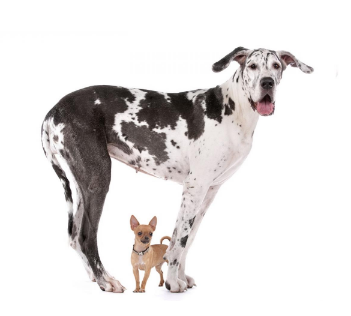The Paradox of Aging in Dogs
The general rule in the animal kingdom is the larger you are the longer you live.
The longest living groups of animals on the planet are elephants and whales – and they are respectively the largest organisms on land and in the ocean. Conversely, mice, and other rodents tend to experience much shorter lifespans.
One strange counterexample (and part of the paradox) is the contrast in lifespan among different sized dog breeds. It is well-known that large dogs don’t live as long as their smaller relatives. For example, mastiffs, weighing up to 230 pounds, live for 6 to 10 years, while chihuahuas, which never weigh more than 6 pounds, live for 14 to 16 years.
Has aging evolved?
In the process of aging, we show the impact living has on our bodies. The process of wear and tear degrades our bodies over time. But this explains how we age, not why, and there is an important difference. Some species have evolved to live much longer than others, so why don’t all species evolve to live longer if aging is avoidable?
Researchers say the answer has to do with the fact that natural selection weakens with age. As we are more likely to be alive a year from now than two years from now, due to the increased chances of accidental death or catching infectious disease, genetic mutations will have more of an impact on an individual while they are young and likely to still be alive than when they are old.
Small dogs versus large dogs
Researchers from the University of Adelaide did a year-long comparative analysis of the causes of differences in lifespan and death in 164 dog breeds, ranging in size from chihuahuas to Great Danes. The data included information on adult body mass, newborn mass, at what age breeds reach 50 percent of their adult mass, litter size, average age of death, cause of death and the distribution of dogs at different ages for each breed.
- “When we analysed these data sets, we discovered that larger dogs were more likely to die from cancer at a younger age when compared with smaller dogs,” said Dr Jack da Silva from the University of Adelaide’s School of Biological Sciences.
- “Larger dogs didn’t necessarily age faster than the smaller breeds, but the research did show that as the breed’s average body weight increased, so did the rates of cancer.”“
We believe the relationship between a dog’s body size and their lifespan may be caused by an evolutionary lag in the body’s cancer defenses, which are unable to keep up with the rapid and recent selective breeding of bigger dogs.
“Dogs represent a good model for studying aging in humans. Dogs, like humans in the industrialised world, live in an environment that tends to protect them from accidental and infectious causes of death and are thus more likely to die from age-related diseases, such as cancer,” said Dr da Silva.
Although the results of this survey may be concerning for owners of large dogs, the researchers predict bigger breeds will evolve to develop better cancer fighting genes.
“Most of the 400 or so dog breeds we know today have only been established in the past 200 years. Larger dogs haven’t had time to evolve better cancer defence mechanisms to match their size. This could still happen, but it may come at a cost to reproduction,” said Dr da Silva.
The scientists predict that larger breeds will adapt and extend their lifespan but based on the theory of aging, they’re more likely to have smaller litter sizes in the future. “This may occur naturally or through selective breeding, as people focus on breeding larger dogs that have lower cancer rates and thus greater longevity.”
